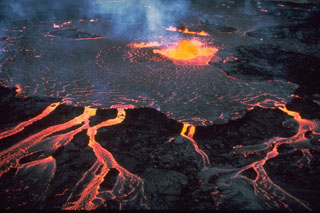Report on Kilauea (United States) — 11 September-17 September 2024
Smithsonian Institution / US Geological Survey
Weekly Volcanic Activity Report, 11 September-17 September 2024
Managing Editor: Sally Sennert.
Please cite this report as:
Global Volcanism Program, 2024. Report on Kilauea (United States) (Sennert, S, ed.). Weekly Volcanic Activity Report, 11 September-17 September 2024. Smithsonian Institution and US Geological Survey.
Kilauea
United States
19.421°N, 155.287°W; summit elev. 1222 m
All times are local (unless otherwise noted)
HVO reported that deformation analysis of an interferogram based on satellite images acquired over Kilauea during 2-14 September indicated that a dike intruded between Pauahi and Makaopuhi craters along the middle East Rift Zone. Seismicity and deformation increased dramatically at around 1600 on 14 September with most of the earthquakes located at depths of 1-3 km below the surface. The largest earthquake was an M 4.3 recorded at 1625 on 14 September and located in the S part of Kaluapele; this earthquake was associated with slip along one of the outer caldera faults and a consequence of stress changes due to the dike intrusion. Activity levels decreased overnight during 14-15 September; seismicity continued at less intense levels on 15 September, though deformation data continued to show moving magma.
During 2100-2200 on 15 September, infrasound instruments detected strong signals typical of gas or steam venting, and seismometers in the middle East Rift Zone recorded weak, sustained, low-frequency tremor. Residents in nearby subdivisions downwind reported smelling volcanic gas around that same time. There was no evidence of eruptive activity in webcam images and GOES satellite data did not show thermal anomalies, though heavy rainfall in the area complicated the interpretation. HVO issued a Volcanic Activity Notice (VAN) at 0023 on 16 September raising the Volcano Alert Level to Watch (the third level on a four-level scale) and the Aviation Color Code to Orange (the third color on a four-color scale) and noting that monitoring data indicated a continuing intrusion. Hawai'i Volcanoes National Park closed the Chain of Craters Road and other nearby areas in response to the increased activity.
During an overflight around 1000 on 16 September HVO scientists confirmed that an eruption had occurred during the night in an area just W of Napau Crater, near the Napau campsite in a remote area of the National Park. Two lava flows had erupted from a 480-m-long fissure with two segments, covering an area of approximately 16,500 square meters; the larger flow was about 200 m long. No active lava flows were seen during the overflight, but gas-and-steam was rising from the fissure. The campground was not affected but lava possibly covered a pulu (Hawaiian tree fern) station nearby, and vegetation along the margins of the flow field was burned. Chain of Craters Road is downslope and downwind of the new fissures.
The eruption resumed at about 1800 on 16 September with the activity visible in webcam images. During an overflight during the morning of 17 September volcanologists observed activity at fissures that had opened on the Napau Crater floor, downrift (NE) of the previous fissures that had opened on 15 September and were no longer active. The fissure on the crater floor was about 500 m long and trended E-W along the N part of the crater floor. Lava fountains rose 10 m from areas along the fissure, and by 0830 about 25-30 percent of the crater floor had been covered by lava. HVO released a map showing the margins the flow field as of 1030 on the 17th, based on observations made during the last helicopter overflight. The map showed that lava from the first set of fissures had flowed NE down into the Napau Crater during 16-17 September. The total length of the fissure system was more than 1.6 km and lava flow covered about 18 hectares (180,000 square meters).
Geological Summary. Kilauea overlaps the E flank of the massive Mauna Loa shield volcano in the island of Hawaii. Eruptions are prominent in Polynesian legends; written documentation since 1820 records frequent summit and flank lava flow eruptions interspersed with periods of long-term lava lake activity at Halemaumau crater in the summit caldera until 1924. The 3 x 5 km caldera was formed in several stages about 1,500 years ago and during the 18th century; eruptions have also originated from the lengthy East and Southwest rift zones, which extend to the ocean in both directions. About 90% of the surface of the basaltic shield volcano is formed of lava flows less than about 1,100 years old; 70% of the surface is younger than 600 years. The long-term eruption from the East rift zone between 1983 and 2018 produced lava flows covering more than 100 km2, destroyed hundreds of houses, and added new coastline.
Sources: US Geological Survey Hawaiian Volcano Observatory (HVO), US Hawaii Volcanoes National Park

